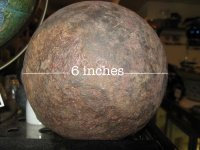A friend of mine recovered this near Petersburg, Va and sent me this photo.
I don't have any other specifics about it, but will try to get some.
I think he is looking for general information.
Thanks for your help, Pete!
I don't have any other specifics about it, but will try to get some.
I think he is looking for general information.
Thanks for your help, Pete!







